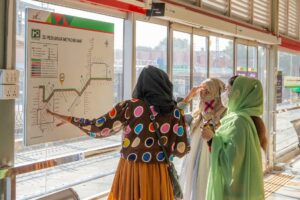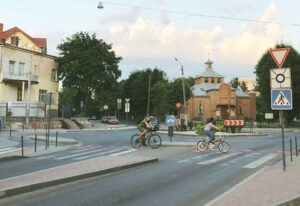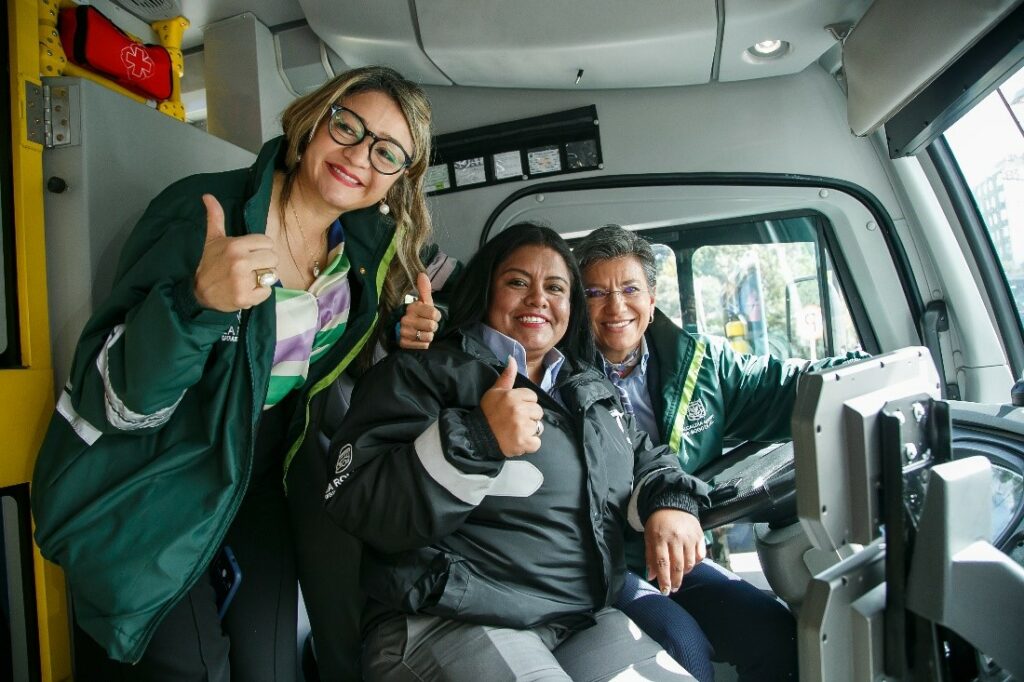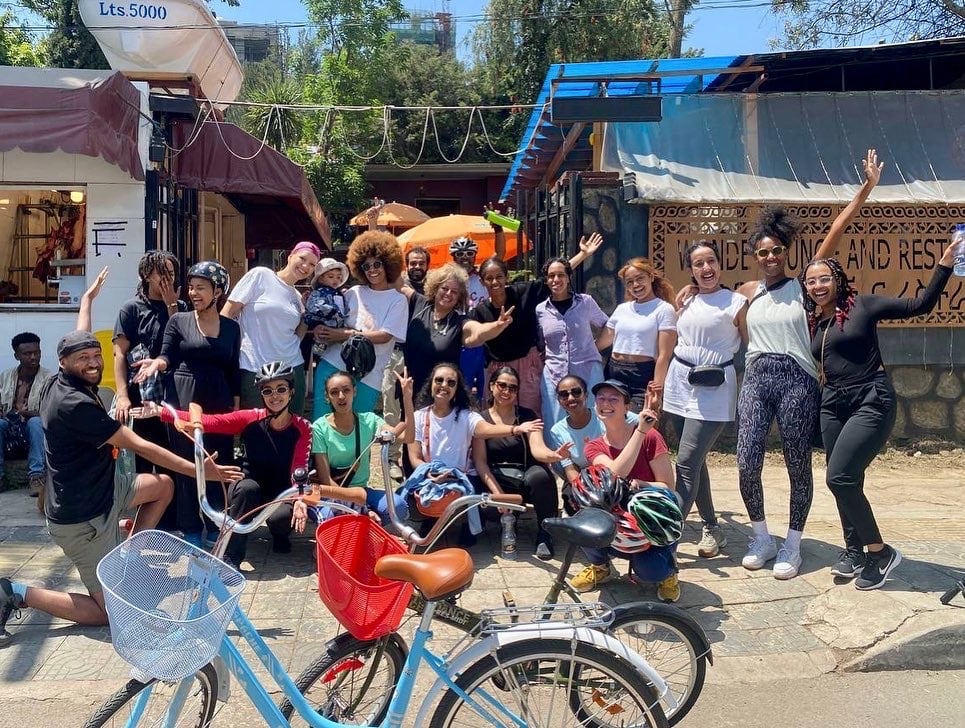The Sustainable Transport Award
Every year, the Institute for Transportation & Development Policy (ITDP) gives the STA to a city. Winners are recognized for transport, street design or policy improvements that increase mobility and improve the quality of life of urban residents with the goal of supporting the often-unrecognized progress in sustainable mobility happening on the ground. The unique global recognition is conferred by a committee of international experts in sustainable transport and development.
The four cities presented here, each nominated for an STA, show that gender-inclusive transport can take many different shapes. Whereas Bogotá has been successful in implementing bike lanes and repurposing car-centric streets, Peshawar has focused on a safe and inclusive BRT system. Tartu and Lviv have taken more holistic approaches, driven by data, participatory budgeting, and community engagement, to create urban mobility that works for everyone.
What can we learn from these cities?
Bogotá: Safety and mobility for all residents
Bogotá has won the Sustainable Transport Award twice (2005 and 2022). The latest win honored the city’s transport interventions designed to improve safety and mobility for the city’s most marginalized residents. The Colombian capital was one of the first cities in the world to create emergency bike lanes during the COVID-19 pandemic. A total of 84 km, with 28 km becoming permanent and 46 km still in use, significantly improved the city’s cycling network, quadrupling bike use on some main roads.
These COVID-19 changes were cemented with official policies. One of them, called Acuerdo 804, established biking as the priority means of transport in future planning efforts in Bogotá, building on the city’s 2020-24 Strategic Plan. The current administration also aims to ensure that gender is factored into all policies as a trans-sectoral issue. The Public Policy for Women and Gender Equity and the accompanying Gender Action Plan are key documents.
Bogotá also reconfigured street space to allow for effective social distancing. Streets that were once only for cars were pedestrianized. This resulted in a total of 44,000 square km of repurposed street space, making it safer to walk for women by improving street lighting for example. Another important initiative in Bogotá focuses on travel safety, especially for low-income children. The Kids First program targets students who commute on foot, by bike, and by public transport. Since women are often in the care-taking role, they directly benefit from this: They can safely accompany their children to school or send them off alone, knowing they will be safe.
Today, Bogotá has a fleet of almost 1,500 electric buses that serve its public transportation system, making it the city with the third largest e-bus fleet outside of China. Crucially, the buses benefit low-income residents as they provide access to their neighborhoods alongside clean air. And with the new “La Rolita” program, a public bus company with an all-electric fleet with a focus on gender equality, women are leading the e-bus movement in Colombia. 48% of drivers of the Rolita buses are women. By focusing on women from the informal workforce and giving them formal employment, La Rolita is tackling inequality in the city. According to the company’s general manager, Carolina Martinez, the female drivers are more in tune with the diverse needs of different riders and youth and are sensitive to requests. Read the case study here.

In Bogotá, women are leading the e-bus movement. Credit: La Rolita
Peshawar: Inclusive transport planning for women, people with disabilities and youth
Peshawar is the first city in India that has implemented a Gold Standard BRT system. Since 2020, “Zu Peshawar” has been moving over 250,000 passengers a day. This provides access to the city for women, people with disabilities and youth. The system is centered on the needs of people who need it the most, which earned Peshawar a STA Honorable Mention in 2022.
Until recently, minibuses and wagons dominated Peshawar’s public transport system. These were not comfortable or safe for people with disabilities and for women. They also contributed to congestion, and the government had no control over supply, demand, or vehicle quality. In addition, these gas guzzling vehicles contributed up to 70% of the city’s air pollution. The outstanding commitment to improving the welfare of residents through an innovative BRT system led to the implementation of Zu Peshawar.
This BRT system has cut travel time in Peshawar by over 60% along the east-west corridor. Fares are low and accessible for most citizens. Female riders and persons with disabilities benefit from targeted infrastructure and interventions, providing a safe and accessible choice for moving around the city. These interventions included separate waiting areas, bathrooms, and ticket booths for women. In addition, all buses have designated priority seating for women. These targeted changes have resulted in an increase of 20% of women as passengers on Zu Peshawar, up from 2%. The number of users in wheelchairs has also increased due to 100% step free entrances and exits as well as level boarding at all stations on the BRT corridor.

The Zu Peshawar BRT system was created using citizen engagement to address the needs of women, transgender people and persons with disabilities. Credit: Asian Development Bank
A key consideration in implementing the Zu Peshawar was citizen engagement to address the needs of women, transgender people and persons with disabilities. Through surveys, workshops, public meetings, and social media as well as mobile phone apps, a Gender Action Plan was created to ensure truly accessible public transport for everyone. Read the case study here.
Tartu: Participatory budgeting and data for green mobility
Since 2012, the city of Tartu in Estonia has been implementing programs, infrastructure, and policy to transform its urban environment through sustainable and accessible mobility. The mid-sized city is an example of how to plan mobility based on data, resident feedback, and climate goals. In 2022, Tartu received an STA Honorable Mention.
Importantly, the city places a focus on data to understand mobility. More than 27 gender-disaggregated datasets have helped to trace how people move throughout the city. This informed the rerouting and placement of bus routes, the locations of bike share stations, and the best spaces for outdoor activity areas. The approach also enabled the city to consider the needs of all genders and create inclusive solutions.
The urban Master Plan of Tartu supports endeavors for more active transport and better e-mobility and public transport by focusing on making public transport options more appealing for everyone. 100% carbon neutral public transport options, shorter travel distances, a main network of cycling tracks, mobility centers in the outskirts, and more public transport to nearby settlements are part of this strategy.
The city of Tartu has engaged with the community and with European organizations to reconsider and readjust initiatives, for example through participatory budgeting. This approach is another example of how to create a gender-inclusive transport strategy since it enables planners to include the opinions and preferences of all genders. In Tartu, allowing the population to vote on how to distribute part of the municipal budget has resulted in a pedestrian and cyclist-friendly redesign of Kroonuaia Street, as well as the renunciation of plans for an inner ring road that had been under discussion since the 1990s. Instead, a 3 km long linear park for pedestrians and cyclists will be built. Read the case study here.
Lviv: From streets for cars to streets for all
Lviv in Ukraine was awarded an STA honorable mention in 2021. The city has seen a transformative journey away from car-centric roads towards pedestrian-friendly streets. It has succeeded in galvanizing public support and political will toward sustainable transport priorities. New city departments, plans, and projects were key to turn Lviv into a city of short distances where people are more important than cars. Even though this example does not center around gender, it shows how to make the city more attractive to everyone by involving members of civil society and NGOs in the planning process, by creatively using data, and by redistributing space. Many of these efforts have been halted in light of Russia’s invasion of Ukraine.

Care-free boulevards in Lviv invite citizens to enjoy their city. Credit: Mana Kaasik
For decades, Lviv has been making efforts to retrofit itself into a city of short distances. Civil society advocates and administration were part of this change despite skyrocketing car ownership since the 1990s. Even though more than half of the city’s residents used public transport, the streets still experienced daily gridlock. Many active members of civil society and NGOs, representing all genders, have inspired the municipal administration to pick up their projects, from the prevention of illegal parking to upgrading the lighting at pedestrian crossings, which in terms of safety is particularly important for women.
A combination of pedestrian improvement projects, cycling projects, and investments in public transport allowed for the redistribution of space. Specially planning budget lines for new infrastructure measures, such as bike lanes, were key. This allowed for smaller interventions to be built within larger projects.

The redistribution of space in Lviv has meant that cycling and walking in the city is now much easier. Credit: Mobility Lviv
Like Tartu, the city of Lviv also creatively used qualitative data along with information from experts and advocates to determine priority intervention areas for cycling infrastructure and pedestrian zones. Pilot programs and tactical interventions were also used to showcase what self-sufficient neighborhoods and short-distance travel to the city center could look like. Considering that women tend to make more frequent and shorter trips with different modes of transport to combine multiple tasks, a good selection of safe, multimodal travel and improved last-mile connectivity is key to their experience of urban mobility.







